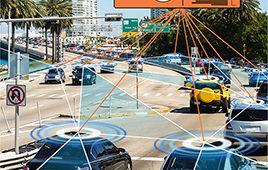Sleepless in Uganda
How cellular technology is changing the world
Randy C. Hice
Entebbe 2241. I can remember the number clearly, even though it’s been 25 years. It started out as a boring summer evening in Kalamazoo. Fighting tedium came in many forms, but lack of funds this evening meant a good, wholesome, home-based activity.
I turned to my roommate, Art.”Let’s call up a murderous dictator and harass him,” I blurted out.
Art seemed to understand, but I couldn’t be sure.
“I have the number right here, Entebbe 2241. Let’s ring him up.”
“Ring who up?” Art demanded.
“Idi Amin.”
Art was now laughing wildly, yet he still eyed me with suspicion.
“I got the number from an Earth News dispatch at the radio station,” I continued, “I’m sure it’s good. The report said he’s a blowhard and loves to talk to reporters.”
“We’re not reporters.”
“We are now, let’s ring him up.”
So after a precarious chain of two or three overseas operators, through a connection that sounded like it was being routed through a couple of paper cups connected by string, we closed to within one obstinate Chief of Staff of speaking to the so-called ‘President for Life’ of Uganda. We might have pulled it off, were it not for a slight time zone miscalculation.
“Yes. This is the New York Times, I’d like to speak to President Amin.”
A thick African accent punctuated the distant connection: “What? Do you know what time it is?”
Art and I suddenly realized our mistake. There was a serious time shift between Eastern Daylight time and East African time, still, we pressed.
“Well tell him the New York Times is calling, and I want a personal interview at once.”
“New York Times, so what? No one can wake the President at this hour.”
“Listen to me, pal. If the President finds out tomorrow morning that you blew his chance for a front page spread, you’re history!”
The aid staggered momentarily, and decided the threat in the nearby bedroom loomed larger than the threat of missed publicity.
“I cannot wake the President,” he said, almost pleading.
Realizing we hit a dead end, I continued, “Tell me, can you confirm that the President plans to float over Victoria Falls in a barrel?”
“What?”
“It’s common here in the U.S. at Niagara Falls. We heard President Amin plans to do the same. We’d like to get his perspective.”
But the connection fell silent, owing to either the impatience of the aid, or the chicken wire and spit connection we had. Art and I convulsed on the floor with laughter, only occasionally did we peer out the window to see if a Ugandan security agent with dark sunglasses was lurking outside.
We take phones and long distance calling for granted now. It is likely the same call could be made with a crystal clear connection, although I didn’t actually try to see if the subsequent governments ever changed the number.
And the advances made in cellular communications have been miraculous. Still, we look at our cell phones as electronic tethers, and their ubiquity renders them all the more banal. Those poor programmers at Nokia, Siemans and Motorola. When we hit the ‘on’ button on our phones, thousands of lines of their intricate code simply fly by unnoticed as the phone powers up. Most people have noticed cellular phones have gotten smaller, but not as many have noticed they are a lot smarter.
Cellular phones have now been doled out by large pharmaceutical and biotech companies as a means of gaining instantaneous access to employees. The price of service has plummeted, so the productivity increase is worth the mutation of the wired to the wireless. Pagers are passé, voicemail is irritating, cellular dog chains are the control freak’s garden.
A whole raft of features in these phones now awaits us, and many more are in the immediate pipeline. Most of us have second generation (2G) cell phones, but 3G phones are being rolled out all over the globe. These phones take photos, provide instant messaging services, ‘always-on’ e-mail, Internet access, and many other services, all at 2 Mbps via the GPRS (General Packet Radio Service) standard. And now, phones have been married to Personal Data Assistants (PDAs), and are actually useful tools.
Ah, but we Americans, always unique. We employed TDMA (Time Division Multiple Access) and CDMA (Code Division Multiple Access) protocols here in the U.S. that are barriers to 3G phones, and also to being able to carry the darned thing outside our borders. This is why some of us, intoxicated by earlier ‘cellular modem’ PCMCIA cards were duped. Firing up these cards from your laptop required switching the signal from digital to analog, and trickling out the message at 4600 Bps. The TDMA and CDMA protocols didn’t handle digital data, so analog was it (analog also fries the batteries on your phone as it is much less efficient than digital). The rest of the planet (with minor exceptions) operates on one of two frequencies on the GSM (Global System for Mobile Communications) protocol. The protocol lends itself to these new 3G features and, thus, many major U.S. carriers are building a GSM (albeit GSM 1900) network.
Western Europe and parts of Asia have outdistanced the U.S. in cellular technology for years. Infrastructures die hard, and there were problems between neighboring countries, and equipment was often indigenous to a particular locale. So, the demand for seamless cellular fueled the development of sophisticated GSM networks in Europe, and the bar fight that we see as cellular competition had a head start overseas. Plans were made very affordable in Europe years ago. One huge difference between the European plans and the U.S. was that the phone company’s penchant for revenue recovery was much greater here (aka Greed is Good). In Europe, most cellular carriers do not charge for incoming calls. That may happen here, but it will be a while before the carriers leave that jack on the table.
Europeans have long been accustomed to roaming between countries and being able to use their phones everywhere. The only glitch, in some cases, is the aforementioned support of two GSM frequencies in Europe. For example, I was recently in Ireland where the standard is GSM 900 but, a few days earlier, I was in the U.K. and the standard is GSM 1800. Even traveling from Ireland to Northern Ireland, the standard changes from GSM 900 to GSM 1800. But the dual band phones sold in Europe effortlessly make this hop, automatically sensing whether GSM 900 or GSM 1800 is present.
However, changing to the GSM standard in the U.S. is a difficult and expensive task. Since most carriers were standardized on TDMA and, to a lesser extent, CDMA, adding GSM to the laundry list means separate equipment transmitters and relays. AT&T is slowly adding GSM equipment to existing TDMA towers and, one day, TDMA will be no more (one also suspects CDMA is moribund).
There is at least one phone on the market (Siemans comes to mind) that makes a handset that not only handles GSM 900 and GSM 1800, but also TDMA and the new US GSM 1900. So, one could cover all the bases. But, realistically, there’s not a huge market for such chameleon phones. The really cool ones are GSM, and come from Motorola, Nokia and Ericksson.
If you live in the U.S. and travel to Europe, and you’re packing a tri-mode (GSM 1900/1800/900) mode phone, you can order cheap prepaid SIM (Subscriber Identity Module) cards off the Internet for nearly every country in the world using GSM. You pop off the back of your phone, remove the battery (in most cases), pop out the existing SIM (a card about the size of a stamp), and plug in the new one. When you then travel to the country for which your SIM is programmed, you have a local number, some included airtime, and now the boss can call you up in the pub and you won’t even be charged for the incoming call.
Finally, 4G phones are in the cards. These will likely not appear until 2010-2012 but, when they do, your data will fly at you at 100 Mbps. Expect the Japanese to be using these years before we do in the U.S. For now, the world slowly moves towards 3G, and we’ll be able to review lab reports, check e-mail, and aimlessly surf the Web. And those of us who enjoy tormenting dictators no longer have to suffer the indignity of overseas operators, we can put ’em on speed dial and make their lives miserable while trapped at a traffic light.
Randy Hice is President of the Laboratory Expertise Center. He can be reached at [email protected].




